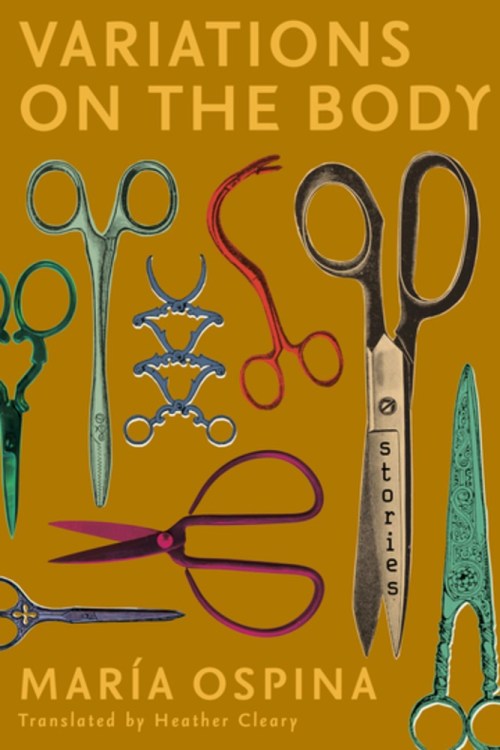[ad_1]
The characters in María Ospina’s debut collection are haunted by the marks that time and trauma have left upon their bodies. Variations on the Body (translated from the Spanish by Heather Cleary) features a cast of loosely connected characters, all hailing from Ospina’s hometown of Bogotá, Colombia. Thematically, with its emphasis on the complex interplay between psychology and the female body, Ospina’s work recalls that of the Argentine writers Mariana Enriquez and Samanta Schweblin, albeit without the horror tropes that those writers employ. Ospina’s aesthetic is overtly realist, and her style is grounded in the careful accumulation of details that add up to a greater whole.
The collection is comprised of six stories, all of them focused on girls and women interacting in different ways with life in the city. Bogotá itself emerges as a secondary character—a place of brutal inequalities where stray dogs roam the streets, and the government builds “peace homes” to house former paramilitary fighters trying to integrate themselves back into civilian life. Though characters occasionally reappear between stories, the collection doesn’t insist strongly upon these connections. The volume also includes an insightful translator’s note from Heather Cleary, in which she writes about the difficulties of rendering Ospina’s “polyvocality” in English and outlines some of the literary and linguistic nuances that may be lost on English readers.
The memory of political violence seeps into many of these stories, but is most apparent in the collection’s first, “Policarpa,” where Marcela, a young woman who has deserted from the FARC, attempts to adjust to her new reality working as a cashier at a big box store. Ospina is aware of the irony of Marcela’s situation; while she once walked through the jungle, reading Marxist pamphlets, Marcela now finds herself serving the capitalist system she once fought against and turning into a willing consumer in her turn. She buys a cream “that claims to scour away impurities and applies it with discipline every morning to the raised scar that interrupts her shoulder. She wants to sand down the pinkish mark so the wound won’t reveal as much.” Ospina positions Marcela as a latter day Policarpa Salavarrieta, the heroine of the Colombian independence movement. Yet whereas “La Pola” defiantly faced a Spanish firing squad, Marcela’s fate is to be absorbed silently back into the capitalist system.
The following story, “Occasion,” features Marcela’s sister, Zenaida, a housemaid for a wealthy family who has just learned she is pregnant. Alternating between Marcela’s perspective and that of her young charge Isabela, Ospina deftly draws a picture of class differences and complex power dynamics while also infusing the characters with individual humanity. In the end, the reader believes both in the affectionate relationship between Isabela and Zenaida, and how quickly Zenaida will be replaced.
In “Collateral Beauty,” a young woman sells the business she has inherited from her father—an old-fashioned doll hospital—and uses the money to travel to New York City, but once there, she finds herself frequenting storefronts, searching for some of her former merchandise. She is not the only character in the collection who moves back and forth between Colombia and the U.S., and who finds that Colombia exerts the stronger pull.
In “Saving Young Ladies,” the protagonist, Aurora, who has returned to Bogotá after living in the U.S., finds herself obsessed with the Catholic “home for women” across the street from her apartment. Ospina writes that, “Aurora wanted to believe that the girls martyred their fingers by biting their nails to the quick, that they chewed the erasers on their pencils down to little nubs, that they impatiently plotted the moment when they could shed the sweaters that bound their bodies and make their escape.” But when Aurora has an erotically charged encounter with one of the girls, she finds that the girl doesn’t want the kind of “salvation” she is offering.
Perhaps the only weak story in this collection is the short “Fauna of the Ages,” in which the narrator muses cleverly upon a flea infestation in her Bogotà apartment, envisioning the creatures as “ the return of the repressed, motivated by hemoglobin. Less metaphysical, more carnal.”: Although thematically in conversation with the rest, this story lacks the others’ scope and ambition.
In the title story, the aging Martica, who has recently lost her beloved husband, discovers that her closest human relationship is with her beautician. After a recent hospital visit, Martica becomes enamored with a pair of surgical scissors that she carries everywhere, using them like a new set of hands:
She was convinced they would stand in for her arthritic hands when she needed to join the tips of her short, crooked fingers to pull on something small or loosen a knot. They would help her open the bag of peanuts she devoured when her taxi got stuck in traffic, or clip the fastenings of everyday objects. She was one of the many who believed in expressing discontent rather than swallowing it. In not letting it accumulate into little tumors. In cutting the vine rather than leaving it to strangle the tree. She had used many images like these to illustrate the idea over the years, but only now had she found the object that manifested her conviction.
Like many of the characters in Variations on the Body, Martica finds a physical object that she can use as a stand-in for her unstable grief and insecurities.
Ospina writes pointedly about the ways that trauma manifests in the female body. Violence is ever present in this collection, but it haunts the background, existing mostly in the space of the unsaid or understated. Meanwhile, Ospina attentively follows her characters as they move through the mundane tasks of everyday life, in the imperfect bodies they’ve been given.

FICTION
Variations on the Body
By María Ospina, tr. Heather Cleary
Coffee House Press
Published July 6th, 2021
[ad_2]
Source link
